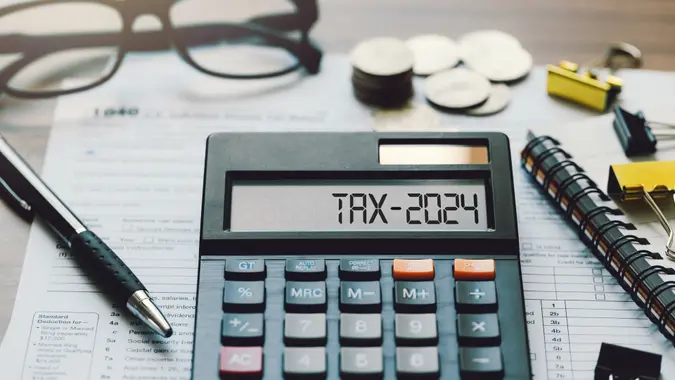Stimulus 2023: Paperwork You Need To Keep for Tax Season

Commitment to Our Readers
GOBankingRates' editorial team is committed to bringing you unbiased reviews and information. We use data-driven methodologies to evaluate financial products and services - our reviews and ratings are not influenced by advertisers. You can read more about our editorial guidelines and our products and services review methodology.

20 Years
Helping You Live Richer

Reviewed
by Experts

Trusted by
Millions of Readers
In 2022, America had its first stimulus-free year since the start of the pandemic, and most people have long received — and probably spent — their federal payments and tax credits. Most, but not all.
In mid-October 2022, the IRS announced it was sending notices to more than 9 million families that were still potentially eligible to collect pandemic-era stimulus payments and tax credits. The letters cited a Nov. 17 deadline that has by now come and gone — but if you’re still eligible for benefits, don’t panic. The deadline pertained only to the IRS’ Free File tool, which the agency made available about a month past the Oct. 14 extension deadline to help potential stimulus recipients file previous-year returns at no cost.
Although you can no longer use Free File to submit old returns, it is not too late to claim any missed stimulus checks or tax credits — but some paperwork is involved. Here’s a refresher on the stimulus-related tax documents you’ll need to get what you’re owed.
You Must File Old Returns To Get Paid
It will soon be time to file your returns for tax year 2022, but if you haven’t already, you must file returns for the previous two years to collect any past-due stimulus payments from the pandemic. According to CNBC, the IRS typically gives taxpayers three years to file past returns and collect any credits they’re owed from those years.
To collect your stimulus money, you must file a return even if you don’t usually do so or if you didn’t earn any income for those years.
Notice 1444-C
The third round of stimulus was for $1,400 per person — $2,800 for couples — plus $1,400 for each qualifying dependent. None of it is included in your gross income and it is not counted as taxable income. Stimulus money neither increases your tax bill nor reduces your refund, and it does not affect your eligibility for benefits programs or government assistance.
Notice 1444-C was sent to everyone who received a 2021 Economic Impact Plan payment from the third round of stimulus. Notice 1444 accompanied the first round of payments in 2020, which was followed shortly by 1444-A, which went to people who had to take action to claim their money. 1444-B followed the second round of payments.
Letter 6419
Direct cash payments were only part of the American Rescue Plan’s stimulus package. Another big wave of relief came in the form of the expanded Child Tax Credit — at up to $3,600 per child for virtually all working families, it was the biggest credit of its kind in history.
If you are eligible for the Child Tax Credit, you might have to reconcile the payments when you file your taxes in 2023. Letter 6419, which the IRS first mailed in January 2022, will give you the total amount of advance Child Tax Credit payments that you’re owed from 2021.
Letter 6475
If you didn’t receive the third Economic Impact Payment, or you didn’t get the full amount you were eligible to receive, you’ll want to recoup the difference by claiming the Recovery Rebate Credit when you file your 2021 tax return.
To do that, you’ll need Letter 6475, which the IRS began sending out in early 2022. Letter 6475 provides the total amount of the portion you receive from the third Economic Impact Payment, as well as any Plus-Up payments.
More From GOBankingRates
 Written by
Written by  Edited by
Edited by 

























